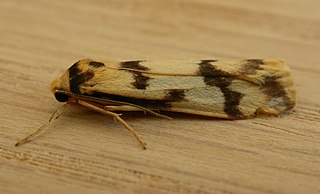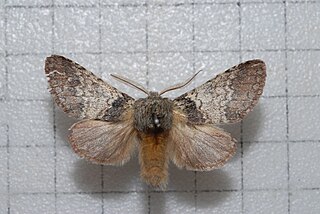| Mellea | |
|---|---|
 | |
| Mellea ordinaria | |
| Scientific classification | |
| Kingdom: | |
| Phylum: | |
| Class: | |
| Order: | |
| Family: | |
| Genus: | Mellea Gaede, 1922 |
Mellea is a genus of moths of the family Thyrididae.
| Mellea | |
|---|---|
 | |
| Mellea ordinaria | |
| Scientific classification | |
| Kingdom: | |
| Phylum: | |
| Class: | |
| Order: | |
| Family: | |
| Genus: | Mellea Gaede, 1922 |
Mellea is a genus of moths of the family Thyrididae.

Armillaria is a genus of fungi that includes the A. mellea species known as honey fungi that live on trees and woody shrubs. It includes about 10 species formerly categorized summarily as A. mellea. Armillarias are long-lived and form the largest living fungi in the world. The largest known organism covers more than 3.4 square miles (8.8 km2) in Oregon's Malheur National Forest and is estimated to be 2,500 years old. Some species of Armillaria display bioluminescence, resulting in foxfire.

Armillaria mellea, commonly known as honey fungus, is a basidiomycete fungus in the genus Armillaria. It is a plant pathogen and part of a cryptic species complex of closely related and morphologically similar species. It causes Armillaria root rot in many plant species and produces mushrooms around the base of trees it has infected. The symptoms of infection appear in the crowns of infected trees as discoloured foliage, reduced growth, dieback of the branches and death. The mushrooms are edible but some people may be intolerant to them. This species is capable of producing light via bioluminescence in its mycelium.

Rhizomorpha subcorticalis is a species name that has been used to characterize certain fungal plant pathogen observations where the pathogen is evident only through mycelial cords ("rhizomorphs"). The species in question very likely also produces reproductive structures which would allow it to be situated in the normal taxonomic tree, especially if DNA analysis is available. A name like R. subcorticalis should only be used where such identification is impossible.

Erebus is a genus of moths in the family Erebidae.
Paranerita is a genus of moths in the family Erebidae erected by George Hampson in 1901.

Tigrioides is a genus of moths in the family Erebidae. The genus was erected by Arthur Gardiner Butler in 1877.

Glyphodes is a genus of moths of the family Crambidae described by Achille Guenée in 1854.

Rivula is a genus of moths in the family Erebidae described by Achille Guenée in 1845.

Callidrepana is a genus of moths belonging to the subfamily Drepaninae.

Tridrepana is a genus of moths belonging to the subfamily Drepaninae.
Guillermo "Bill" Gaede is an Argentine engineer and programmer who is best known for Cold War industrial spying conducted while he worked at Advanced Micro Devices (AMD) and Intel Corporation (Intel). While at AMD, he provided the Cuban government with technical information from the semiconductor industry which the Cubans passed on to the Soviet bloc, primarily to the Soviet Union and East Germany. In 1992, Gaede turned himself over to the Central Intelligence Agency (CIA), which placed him in contact with the Federal Bureau of Investigation (FBI). The FBI began working with Gaede in a counter-espionage operation intended to penetrate Cuban intelligence using his contacts on the island. During this time Gaede obtained work at Intel Corp. in Chandler, Arizona. Intel Security discovered the nature of his activities at AMD and terminated him, but not before Gaede filmed Intel's state-of-the-art Pentium process from home.
Max Gaede was a German engineer and entomologist of international fame who described several hundred of new species of Lepidoptera, mainly African Noctuidae.

Pseudofentonia is a genus of moths of the family Notodontidae erected by Embrik Strand in 1912.

Striglina is a genus of moths of the family Thyrididae described by Achille Guenée in 1877.

Armee-Abteilung Gaede / Armee-Abteilung B was an army level command of the German Army in World War I. It served on the Western Front throughout its existence and formed the extreme left wing.

Rhodoneura is a genus of moths of the family Thyrididae described by Achille Guenée in 1858.